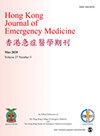远程教育和现场教育在程序镇静镇痛方面的比较:一项随机对照试验
IF 0.8
4区 医学
Q4 EMERGENCY MEDICINE
引用次数: 0
摘要
尽管对程序性镇静和镇痛培训的需求不断增加,但可用的教员数量仍然有限。本研究的目的是比较远程教育和面对面学习在程序镇静和镇痛教育中的知识获取和参与者满意度。我们在日本进行了三次比较远程教育和面对面学习的随机对照试验。每个课程的20名参与者被随机分为五组,按毕业年份进行分层。这些小组被随机分为远程教育组或面对面小组。我们对手术镇静和镇痛知识进行了前后测试,并使用0(不够)到100(足够)的量表调查了参与者的感知。我们的主要成果是知识获取和讨论质量。我们将48名医疗保健专业人员纳入分析。41名参与者(83.6%)为男性,中位经验年限为5年(四分位间距:3-9)。两组在测试前和测试后的得分差异中都有相似的知识获取,除了音频质量的清晰度外,他们在讨论质量上的得分也相似(93比100,p=0.017)。在一项镇静课程远程学习与面对面学习的随机试验中,除了案例讨论的音频质量外,我们没有观察到两组在知识获取和参与者满意度方面的统计学显著差异。需要进一步努力提高远程学习在程序镇静和镇痛教育中的质量。本文章由计算机程序翻译,如有差异,请以英文原文为准。
Comparison of distance education and in-person education in procedural sedation and analgesia: A randomized controlled trial
Despite the increasing demand for procedural sedation and analgesia training, the number of available instructors remains limited. The aim of this study is to compare distance education with in-person learning for knowledge acquisition and participant satisfaction in procedural sedation and analgesia education. We conducted a randomized controlled trial comparing distance education with in-person learning in Japan on three occasions. Twenty participants per course were randomly divided into five groups with stratification by year of graduation. The groups were randomized to either a distance education group or an in-person group. We conducted pre- and post-testing of procedural sedation and analgesia knowledge and surveyed participants’ perceptions by using a scale ranging from 0 (not enough) to 100 (enough). Our primary outcomes were knowledge acquisition and the quality of discussion. We included 48 healthcare professionals in the analysis. Forty-one participants (83.6%) were men and the median years of experience was 5 (interquartile range: 3–9). Both groups had similar knowledge acquisition with the pre-test and post-test score difference and reported similar scores on the quality of discussion with the exception of the clarity of audio quality (93 vs 100, p = 0.017). In a randomized trial of distance versus in-person learning for the sedation course, we did not observe statistically significant differences in knowledge acquisition and participant satisfaction between the two groups except for audio quality for the case discussion. Further efforts to improve quality for distance learning in procedural sedation and analgesia education are needed.
求助全文
通过发布文献求助,成功后即可免费获取论文全文。
去求助
来源期刊

Hong Kong Journal of Emergency Medicine
EMERGENCY MEDICINE-
CiteScore
1.50
自引率
16.70%
发文量
26
审稿时长
6-12 weeks
期刊介绍:
The Hong Kong Journal of Emergency Medicine is a peer-reviewed, open access journal which focusses on all aspects of clinical practice and emergency medicine research in the hospital and pre-hospital setting.
 求助内容:
求助内容: 应助结果提醒方式:
应助结果提醒方式:


